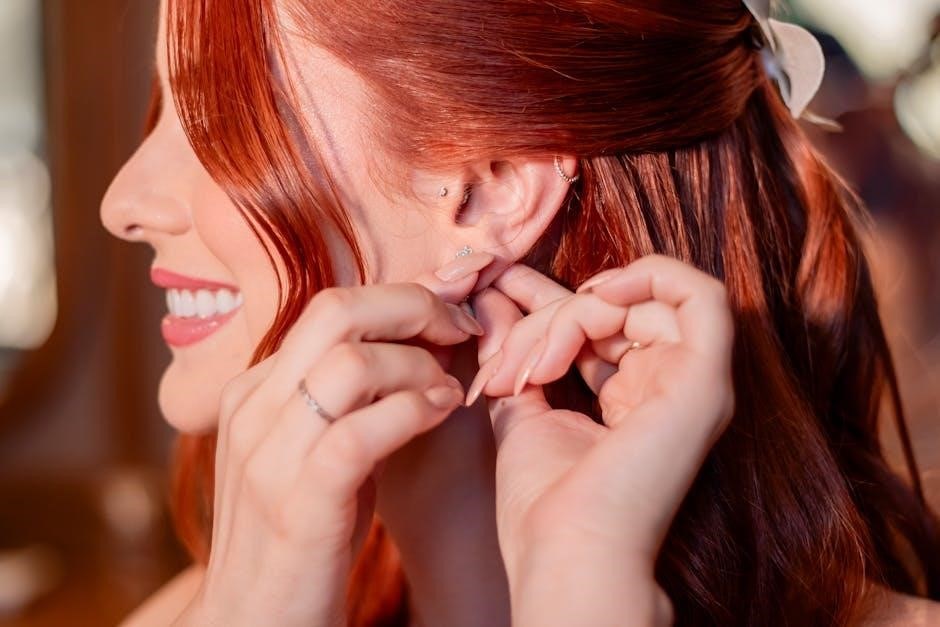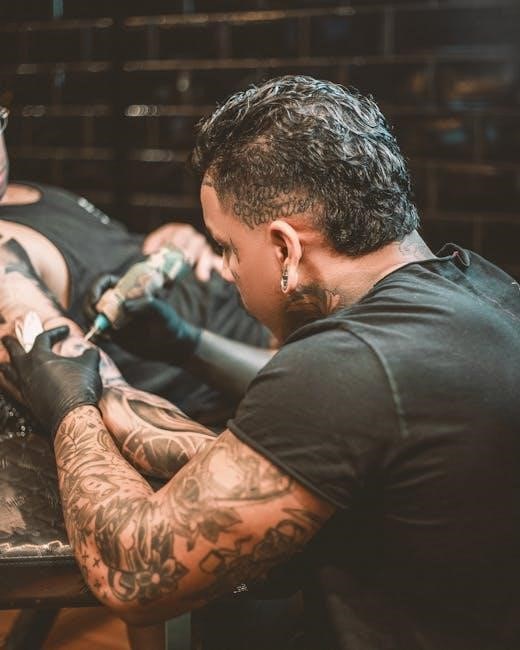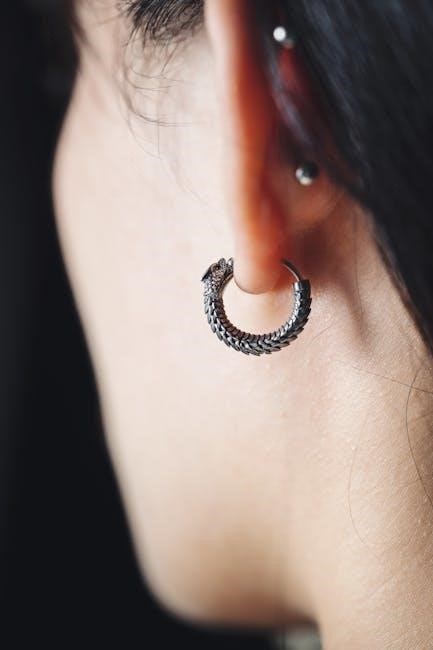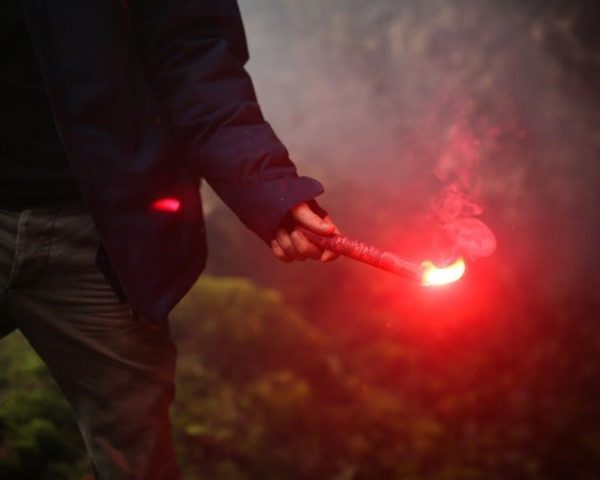Ear piercing is a timeless form of self-expression, blending cultural heritage with modern style. It offers a versatile way to enhance personal beauty and showcase individuality through various styles and jewelry options.
1.1 History and Cultural Significance of Ear Piercing
Ear piercing has deep roots in ancient cultures, serving as a symbol of status, spirituality, and identity. In many civilizations, such as Egyptian and African cultures, piercings signified wealth, power, or religious devotion. Over time, it evolved into a global practice, blending tradition with modern aesthetics. Today, ear piercing remains a meaningful form of self-expression, connecting individuals to their heritage while embracing contemporary styles and personal identity.
1.2 Popularity of Ear Piercing as a Form of Self-Expression
Ear piercing has become a popular way to express individuality, offering a canvas for creativity and personal style. With various piercing types and jewelry options, it allows people to showcase their uniqueness. From subtle studs to bold designs, ear piercings empower individuals to convey their identity and attitude. This accessible form of self-expression appeals to all genders and ages, making it a timeless and universal way to embrace personal style and confidence.

Types of Ear Piercings
Ear piercings vary widely, from the classic lobe to trendy options like helix, tragus, daith, rook, and conch. Each offers unique styling opportunities and personal expression.
2.1 Lobe Piercing
The lobe piercing is the most common and versatile ear piercing, located at the soft tissue of the earlobe. It heals quickly and is ideal for all ages. This piercing is great for those with sensitive skin and offers endless styling options. Popular jewelry choices include studs, hoops, and dangle earrings. Lobe piercings are perfect for first-time piercees and allow for creative expressions, making them a timeless favorite in ear piercing culture.
2.2 Helix Piercing
The helix piercing is located on the upper rim of the ear, offering a sleek, modern aesthetic. It’s a popular choice for those seeking an edgy look. This piercing is versatile, accommodating studs, hoops, or rings. Healing is generally smooth with proper aftercare. The helix is ideal for those wanting a subtle yet striking addition to their ear stack. Its placement allows for creative styling, making it a favorite among piercing enthusiasts looking to enhance their personal style with minimal effort.
2.3 Tragus Piercing
The tragus piercing is situated on the small flap of cartilage in front of the ear canal, adding a delicate, sophisticated touch. It’s a popular choice for those seeking a subtle yet striking look. This piercing is ideal for minimalists who want to enhance their ear’s natural beauty. The tragus is a versatile spot, often adorned with small studs or rings. While healing can take several months, proper care ensures a smooth process. Its discreet placement makes it a favorite for those looking to add a touch of elegance without being overly bold.
2.4 Daith Piercing
The daith piercing is located in the inner fold of the ear, just above the tragus, creating a bold, eye-catching look. It’s often adorned with rings or curved barbells, making it a standout piece. This piercing is popular for its unique placement and ability to add a touch of edginess to any style. The daith is a favorite for those looking to experiment with industrial or minimalist aesthetics, offering a striking contrast to the ear’s natural curves. Its inner positioning makes it a versatile choice for various jewelry styles.
2.5 Rook Piercing
The rook piercing is situated in the upper cartilage of the ear, between the helix and daith, offering a striking, industrial aesthetic. It’s ideal for those seeking a bold, edgy look. Typically adorned with curved barbells or hoops, the rook piercing adds a unique touch to any style. Its placement allows for versatility, complementing other piercings or standing alone as a statement piece. This piercing is perfect for individuals looking to explore more adventurous and modern ear styling options.
2.6 Conch Piercing
The conch piercing is located in the shell-shaped area of the ear, offering a sleek, modern aesthetic. It can be pierced on the inner or outer conch, with the inner conch being more discreet; This piercing is ideal for those who prefer a subtle yet stylish look. Jewelry like hoops or studs complement the conch’s natural curve, enhancing the ear’s beauty. Its versatility makes it a popular choice for both minimalist and bold ear styling.
The Piercing Process
The piercing process involves preparation, a sterile needle procedure, and aftercare guidance. It’s essential to eat, hydrate, and avoid alcohol beforehand for optimal comfort and safety.
3.1 Preparation for Getting an Ear Piercing
Preparation is key for a smooth ear piercing experience. Eat a light meal, stay hydrated, and avoid alcohol or blood thinners beforehand. Ensure the studio uses sterilized equipment and high-quality jewelry. Research the type of piercing you want and discuss any concerns with your piercer. Proper preparation helps minimize discomfort and promotes healing.
3.2 The Piercing Procedure: What to Expect
The piercing procedure is quick and involves minimal discomfort. A sterilized needle or piercing gun is used, depending on the type of piercing. You’ll feel a brief pinch as the needle passes through the tissue. A professional piercer will guide you through the process, ensuring accuracy and safety. After the piercing, they will provide aftercare instructions to promote proper healing. The entire process is quick, with most piercings taking only a few minutes.
3.3 Choosing the Right Jewelry for Your Piercing
Selecting the right jewelry for your piercing is crucial for comfort and style. Opt for high-quality materials like surgical stainless steel, titanium, or solid gold, which are hypoallergenic and suitable for new piercings. Avoid inexpensive metals that may cause allergic reactions. Consider the piercing type and your lifestyle when choosing between studs, hoops, or rings. Consulting a professional piercer ensures the jewelry fits properly and complements your ear’s anatomy for optimal healing and aesthetics.

Aftercare and Healing
Proper aftercare is essential for healing ear piercings. Maintain hygiene, avoid irritants, and monitor healing times to ensure a smooth recovery process and prevent complications.
4.1 Importance of Proper Aftercare for Ear Piercings

Proper aftercare is crucial for the healing of ear piercings, preventing infections and promoting a smooth recovery. Cleanliness is key to avoid complications, ensuring the piercing heals correctly and maintains its appearance. Regular cleaning with saline solution and avoiding irritants like tight clothing or harsh products are essential. Proper aftercare also helps prevent bumps and scarring, ensuring the piercing remains comfortable and aesthetically pleasing. Consistency in aftercare routines supports long-term piercing health and longevity. Neglecting aftercare can lead to prolonged healing or infections, so diligence is vital for optimal results.
4.2 Healing Times for Different Types of Ear Piercings
Healing times vary for different ear piercings, ranging from a few weeks to several months. Lobe piercings typically heal within 6-8 weeks, while cartilage piercings, like helix or tragus, may take 3-6 months. Proper aftercare and avoiding irritants can significantly reduce healing durations. Factors like jewelry choice and individual healing rates also influence recovery. Patience is key, as rushing the process can lead to complications. Understanding healing timelines helps set realistic expectations for new piercings.
4.3 Common Mistakes to Avoid During the Healing Process
During the healing process, avoid touching the piercing excessively, as this can introduce bacteria. Refrain from using harsh cleaning products or submerging the piercing in water, such as in pools or hot tubs. Tight or inappropriate jewelry can irritate the area, so choose the right size and material. Overcleaning is also a mistake, as it can strip the piercing of its natural protective layer. Lastly, avoid changing jewelry too soon, as this can disrupt the healing process. Proper aftercare is essential for a smooth recovery.

Jewelry Options for Ear Piercings
Explore various jewelry options like studs, hoops, and rings, available in materials such as gold, silver, and platinum. Choose styles that suit your piercing location and personal aesthetic.
5.1 Types of Jewelry Suitable for Ear Piercings
Ear piercings can be adorned with various jewelry types, including stud earrings, hoop earrings, and dangle earrings. Studs are ideal for new piercings due to their simplicity and comfort, while hoops and dangles add flair. Rings and barbells are popular for cartilage piercings, offering a bold look. Each style enhances the piercing’s aesthetic, allowing individuals to express their unique taste and create a personalized look. Proper sizing and material choice ensure comfort and longevity.
5.2 Materials Used for Piercing Jewelry: Pros and Cons
Ear piercing jewelry is crafted from various materials, each with unique advantages. Surgical stainless steel and titanium are hypoallergenic, durable, and ideal for sensitive skin. Gold and platinum are luxurious but may cause reactions in some individuals. Glass and acrylic jewelry are lightweight and affordable but less durable. Proper material selection ensures comfort, safety, and longevity of the piercing. Always choose high-quality, body-safe options to minimize risks and enhance the overall piercing experience.
5.3 Styling Tips for Different Ear Piercing Jewelry
Styling ear piercing jewelry allows for personal creativity and flair. Hoop earrings are versatile and can be paired with studs for a layered look. Drop earrings add elegance, while minimalist designs offer subtle charm. Mixing textures and materials creates visual interest, while matching jewelry styles enhances cohesion. Consider pairing bold pieces with simpler ones for balance. Proper jewelry sizing ensures comfort and prevents damage. Experiment with stacking or asymmetrical designs to express your unique aesthetic and make your piercings truly stand out.

Safety and Hygiene
Safety and hygiene are crucial for successful ear piercing. Always choose a reputable studio with sterilized equipment. Proper sanitization prevents infections and ensures a smooth healing process.
6.1 Importance of Sterilization in Ear Piercing
Sterilization is vital in ear piercing to prevent infections. Reputable studios use autoclaves to sterilize equipment, ensuring all tools are bacteria-free. Proper hygiene practices, like using disposable needles and gloves, further minimize risks. Sterilization ensures a safe environment for the piercing procedure, reducing the chance of complications and promoting healthy healing. Always verify that your piercer follows strict sterilization protocols before proceeding.
6.2 Recognizing Reputable Piercing Studios
A reputable piercing studio adheres to strict hygiene and safety standards. Look for studios affiliated with professional organizations, such as the Association of Professional Piercers (APP). Ensure they use autoclaves for sterilization and disposable needles. A clean, well-maintained environment and experienced piercers are key indicators of a trustworthy studio. Always check reviews and ask questions to confirm their practices before committing to a piercing session.
6.3 Signs of Infection and How to Address Them
Signs of infection include redness, swelling, discharge, or pain around the piercing. If you notice these symptoms, gently clean the area with saline solution. Avoid harsh products or removing jewelry, as this can worsen the infection. Consult a professional piercer or healthcare provider for guidance. They may recommend antibiotic ointments or further treatment. Prompt action is crucial to prevent complications and ensure proper healing.

Ear Piercing for Specific Groups
Ear piercings cater to diverse groups, including men seeking stylish options, professionals navigating workplace policies, and individuals with allergies or medical conditions requiring special considerations.
7.1 Ear Piercing for Men: Styles and Considerations
Ear piercings for men have become increasingly popular, offering a sleek, modern way to express personal style. Popular styles include the lobe, helix, tragus, and daith piercings, each suitable for different aesthetics. Men often opt for minimalist jewelry like studs or small hoops to maintain a subtle look. When choosing a piercing, consider facial features and personal style to ensure the piercing complements overall appearance. Proper aftercare and high-quality jewelry are essential for a smooth healing process and a polished finish.
7.2 Workplace Policies on Visible Piercings
Workplace policies on visible piercings vary widely depending on the industry and company culture. Some employers maintain strict grooming standards that prohibit visible piercings, while others are more lenient. It’s essential to review your workplace’s dress code or grooming policy before getting a piercing. Consulting with HR or referring to the employee handbook can provide clarity. Starting with discreet piercings, like a small stud, can help ensure compliance. Ultimately, consider your industry’s norms when choosing a piercing to maintain professionalism.
7.3 Piercing Considerations for People with Allergies or Medical Conditions
Individuals with allergies or medical conditions must exercise caution when considering ear piercings. Metal allergies, particularly to nickel, are common, so opting for hypoallergenic materials like surgical stainless steel or titanium is crucial. Those with certain medical conditions, such as bleeding disorders, should consult a healthcare provider before piercing. Additionally, individuals with compromised immune systems may face higher infection risks. Choosing a reputable piercer and discussing health concerns beforehand ensures a safer experience.


